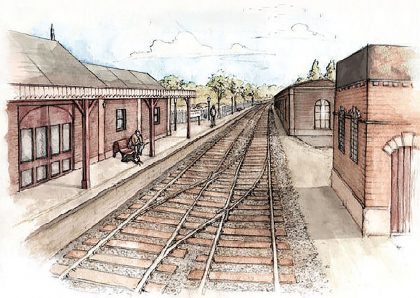


BOOK REVIEW
Change at Robertsbridge: The Rother Valley (Light) Railway (1897-1904), by David Penn, published via Amazon (ebook, £5; paperback, £8.65)
There are numerous books about the Rother Valley/Kent & East Sussex Railway either pre-heritage or post-heritage. In this book the author investigates the group of railway professionals and entrepreneurs who managed to deliver a railway that local interests had spent decades pleading for in vain.
It is the result of in-depth research by the author over a decade or so looking at RVR company records at the National Archive including minutes of directors’ meetings, debenture holder registers, records of the rival Tenterden Railway and, for comparison, records of the Cleobury, Mortimer and Ditton Priors Light Railway in Shropshire (CM&DP) as well as newspaper and census records.
It is not a traditional railway history and has only 47 illustrations but should interest readers who want to understand more about the financial obstacles that all light railways had to overcome, especially the Rother Valley Railway’s first few perilous years.
Colonel Holman Stephens (see Bygone Kent, Vol 41, No 5 is a key character in the story but as his contribution has been well described in many other books the author has decided to focus on other key figures, particularly Myles Fenton (chairman) and John Barrett Lennard (company promoter and director of the London and Scottish Contracts Co).
The increasingly important role of Colonel Stephens, the “king of the light railways”, is acknowledged throughout narrative. The significance of his professional and family connections in securing investments for the railway are explored and some interesting new links are described.
David Penn’s exploration of the railway’s debenture holders shows that the railway’s financial support came from small elite of railway and stock broking professionals at the heart of the late 19th-century business world.
While the ebook is in colour, the paperback is B&W apart from the cover (which approximates the RVR livery).
All royalties from sales of the book bought via Amazon are being donated to the Kent and East Sussex Railway, which as you will realise could be vital funds during the Covid-19 lockdowns when much revenue has been lost.
This book will also be of interest to those who would like to know the early history of how the funding for the railway was raised. This is important even now in that the link to Robertsbridge mainline station could be re-established as the line from Bodiam towards Robertsbridge and from Robertsbridge toward Bodiam is slowly being rebuilt.
Once reopened, visitors could visit places along the line directly from London, changing at Robertsbridge to the heritage line and eventually being able to travel all the way to Tenterden. This would certainly help in reducing road traffic.
Dana Wiffen